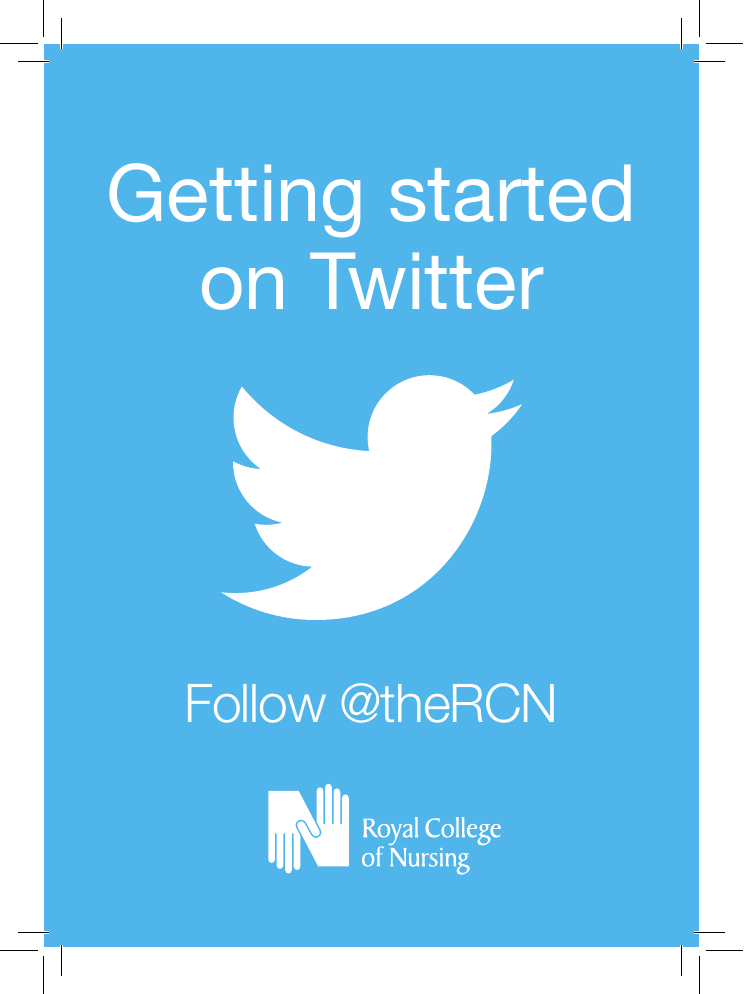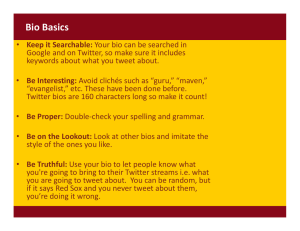Getting started on Twitter Twitter top tips Why tweet?
advertisement

Getting started on Twitter Follow @theRCN d Why tweet? Social media is here to stay. Half of the UK population use Facebook, around a third use Twitter and YouTube is the country’s second most popular search engine. Not using social media potentially means ignoring a huge group of people who could be finding out about and championing the work that you do. The people, places and organisations that matter to you are already on Twitter. It’s an effective way to recruit new members, campaign for change, meet nursing professionals and raise awareness of the difference you make. But remember, your tweets can be seen and shared by others so don’t post anything that could be perceived as bringing your patients, profession, regulator or employer into disrepute. Register Sign up for a free account at twitter.com. Select an @username. This is your Twitter identity and should include your name or something to identify you. Complete your profile with a picture and some information about yourself: lead nurse, keen walker, etc. Once registered, search for accounts to follow and interact with. Twitter will suggest accounts based on your interests and personal information. Alternatively, use the search bar to discover people, places and organisations. Follow, retweet and favourite Similar to a Facebook friend, if you follow someone on Twitter, it means their tweets will appear on your live feed. Don’t be afraid to follow people who interest you, even if you don’t know them – they might follow you back. When you find something interesting, retweet (RT) it. This will repost the tweet onto your own timeline for all of your followers to see. Popular posts are retweeted in large numbers and seen by lots of people. Add comments to messages you retweet, reply to start a conversation or use the favourite button to show you approve of a tweet. Mentions Including the @username of another Twitter user in your tweet is called a mention. The account included in your tweet will get a notification to alert them. You don’t have to follow or be followed by someone to mention them. Remember, if you include the @username at the beginning of a tweet, it will only be visible to people who follow you and the person you are tweeting. If you want your tweet to be visible to all of your followers, add a full stop before the @username or include the @username in the middle of the tweet. #Hashtags Use hashtags to tag a particular word or set of words within a tweet. This is usually the theme of the tweet such as #WorldCup or #RoyalBaby. Including a hashtag before a word or phrase will turn it into a clickable link. Clicking on a hashtag will display all of the tweets about this topic worldwide. Your tweet is part of a much wider conversation on Twitter. Other users can discover your account, tweet or follow you and share what you have said. The most-used hashtags are known as trending topics and often reflect the big news story of the day. Direct messages All tweets are public, and other users can see who you have been talking to on your profile. For private conversations, use Twitter’s direct messaging facility. Direct messages can only be exchanged by people who follow each other, unless you allow messages from all users. Search and discover Use Twitter search to find people, organisations, hashtags or key words. You can also use Twitter’s discover feature to find news stories and trending topics that are relevant to you. Twitter top tips Tweets are 140 characters long but remember to leave 23 characters free to insert a picture and the same for a link. Don’t be afraid to abbreviate but make sure users can understand what you post. Hashtags are important, but don’t use them for every word – save them for the important stuff. Use pictures to get your tweets noticed. Increase your followers by interacting with your audience. Ask questions and speak to people. Don’t be afraid to follow others. Tweets are public. Be yourself but don’t tweet anything you wouldn’t want your manager or a journalist to read. October 2015 Publication code: 005 031 G






